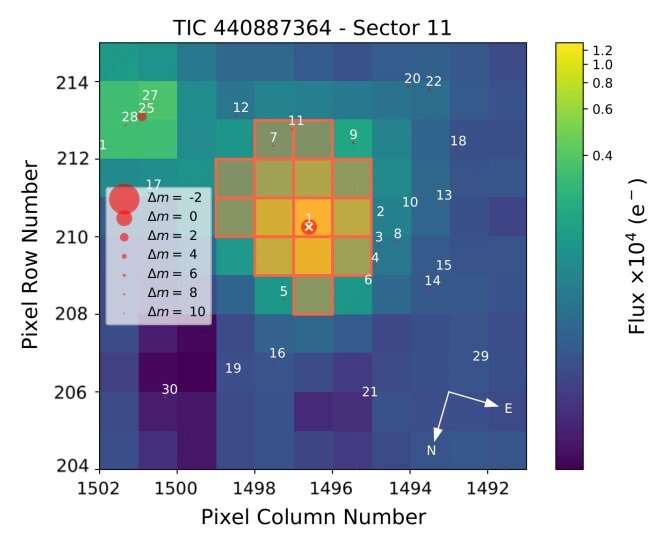
Using the Transiting Exoplanet Survey Satellite (TESS), an international team of astronomers has discovered two new exoplanets orbiting a nearby star known as TOI-836. The newfound alien worlds were classified as a super-Earth and a mini-Neptune. The finding is reported in a paper published August 15 on arXiv.org.
TESS is conducting a survey of about 200,000 of the brightest stars near the sun with the aim of searching for transiting exoplanets. So far, it has identified over 5,800 candidate exoplanets (TESS Objects of Interest, or TOI), of which 233 have been confirmed so far.
Now, a team of astronomers led by Faith Hawthorn of the University of Warwick, U.K., confirms another two exoworlds monitored by TESS. They report that transit signals have been identified in the light curve of TOI-836 (or TIC 440887364)—a K-dwarf star located some 90 light years away. The planetary nature of these signals was confirmed by follow-up observations using ESA’s CHaracterizing ExOPlanet Satellite (CHEOPS) and various ground-based facilities.
“In this paper, we have presented the TOI-836 system and the discovery of its two planets, TOI-836 b and TOI-836 c. We base our discovery upon data from two sectors of TESS data (11 and 38 from year 1 and year 3 respectively) at 2-minute cadence, and a further five space-based observations ranging from 2020 to 2021 from CHEOPS, which are complemented by ground-based photometry from the NGTS, MEarth, LCOGT and ASTEP facilities,” the researchers wrote in the paper.
The inner planet TOI-836 b has a radius of about 1.7 Earth radii and is around 4.5 times more massive than the Earth, which yields a density at a level of 5.02 g/cm3. The extrasolar world orbits its host every 3.81 days, at a distance of approximately 0.0042 AU from it and its equilibrium temperature is estimated to be 871 K. Therefore, due to its parameters, TOI-836 b is a so-called “super-Earth.”
Super-Earths are planets more massive than Earth but not exceeding the mass of Neptune. Although the term “super-Earth” refers only to the mass of the planet, it is also used by astronomers to describe planets bigger than Earth but smaller than the so-called mini-Neptunes (with a radius between two to four Earth radii).
The “mini-Neptune” TOI-836 c is about 2.6 times larger and 9.6 times more massive than our planet. Hence, its density was calculated to be 3.06 g/cm3. The planet has an orbital period of about 8.6 days and is separated from the parent star by 0.0075 AU. Its equilibrium temperature was estimated to be at a level of 665 K.
The host TOI-836 is a 5.4-billion-year-old K-dwarf about 33 percent smaller and less massive than the sun. It has an effective temperature of about 4,552 K and its metallicity is estimated to be -0.284.
The astronomers noted that significant transit timing variations within their observations of this TOI-836 c may indicate the presence of a third non-transiting planet in the studied system.
“However, we find no transits of a third planet within our current set of photometry data, or any indication of an additional periodic signal in our current radial velocity data,” they concluded.
Explore further
Faith Hawthorn et al, TOI-836: A super-Earth and mini-Neptune transiting a nearby K-dwarf. arXiv:2208.07328v1 [astro-ph.EP], arxiv.org/abs/2208.07328
© 2022 Science X Network
Two planets orbiting nearby star discovered with TESS (2022, August 25)
retrieved 26 August 2022
from https://phys.org/news/2022-08-planets-orbiting-nearby-star-tess.html
part may be reproduced without the written permission. The content is provided for information purposes only.